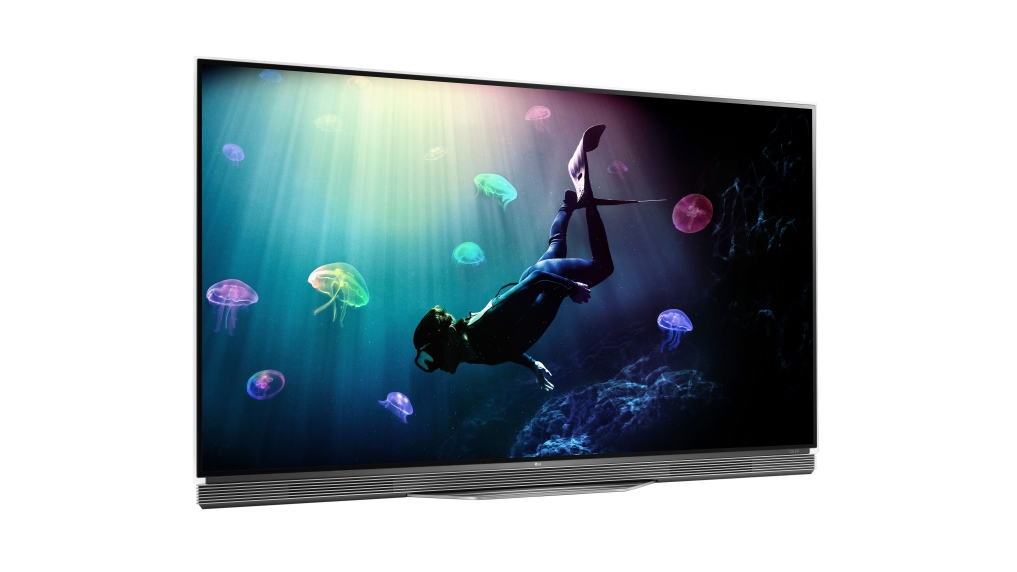TechRadar Verdict
LG's latest OLED is pricey, yes, but offers exceptional clarity when given 4K HDR content and a plethora of apps on its well-rounded LG Content Store.
Pros
- +
Ground-breaking contrast
- +
Beautiful, ultra-thin design
- +
Improved smart TV interface
- +
Spectacularly rich colors
Cons
- -
Steep sticker price
- -
TruMotion can be annoying
- -
Upscaling could use improvement
Why you can trust TechRadar
There aren't many TVs that I look forward to every year. At this point I've seen what most 4K Ultra-HD sets are capable of, and while the addition of High-Dynamic Range (HDR) capabilities have reinvigorated my curiosity some, the TVs I actually look forward to having in my home for weeks on end are few and far between.
But the exception to that rule is LG's line of OLED TVs, which many consider the pinnacle of audiovisual hardware on the market today.
You've read about OLED elsewhere before, I'm sure, so I won't spend much time on it here and I'll just cover the basics. In brief, OLED passes an electric current through organic light-emitting diodes to create color on the screen. Each individual LED can be individually controlled, which means there's no need to have giant lamps sitting on the side of the screen or scattered uniformly across the back of the panel.
OLED screens are more uniformly lit than LCD LED screens, have a better contrast ratio and, in most cases, have richer, more natural colors, too.
LG's OLED65E6P, this year's $5,500 65-inch flagship TV from the South Korean electronics manufacturer, excels at everything I've already mentioned but also surprised me with so much more like built-in screen casting capabilities, 3D and a surprisingly useful universal search function.
Design
Now, if I told you that the OLED E6 is but one of four separate OLED series from LG, you might be a bit confused. Worse, though, is LG's naming system for the awesome panels – one letter followed by a 6. What separates the OLED E6 from its siblings –the G6, C6 and B6 – is that it the C6 is curved, but doesn't have a soundbar. The E6 has a 2.2 stereo soundbar, but it's not as powerful as the 4.2 soundbar that's attached to the G6. Meanwhile the B6 is a bit chunkier in the back than the E6's slim picture-on-glass, 2.57mm thick panel. In short, choosing this specific OLED over the others is a matter of screen preference – curved or flat – and whether or not you're prepared to buy an external soundbar.
If you're looking for the hard numbers, the OLED E6 is an ultra-slim 57.5 x 35.2 x 2.2 inches (L x H x W) without a stand, and 57.5 x 35.2 x 7.9 inches with a stand. It's a hefty 50 pounds (22.6kg), making it fairly stable on a wide enough entertainment center and just hefty enough that you'll need a second person if you have any thoughts of mounting it on the wall.
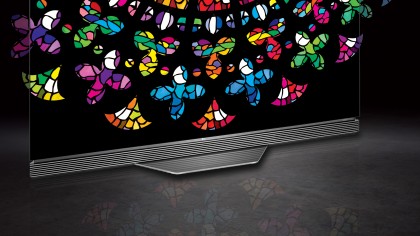
As for the screen itself, it's a gorgeous all-glass front. In years past, that might've meant that it'd be especially reflective, but the E6 doesn't fall prey to previous models' faux-pas. Even in a bright room, the screen retains a great deal of color and clarity, while a super thin trim gives the E6 a picture frame-esque appearance.
Input-wise, however, the OLED E6 isn't the end-all, be-all of connected home devices. On the left-side of the screen you'll find four HDMI ports with HDCP 2.2 and three USB 2.0 ports, alongside composite and component in, ethernet and optical audio ports. What's there is the basics, enough for most typical home entertainment enthusiasts, but not enough for those of us with multiple games consoles, HTPCs and 4K Blu-ray players.
TL;DR: Great design
Screen sizes available: 55 and 65 inches | 4K: Yes | HDR: Yes | Panel technology: OLED | Smart TV: Yes, webOS 3.0 | Curved: No | Dimensions: 57.5 x 35.2 x 2.2 inches | 3D: Yes | Inputs: 4 x HDMI with HDCP 2.2, 3 x USB 2.0, Component, Composite, Ethernet, Optical Audio
Smart TV (webOS 3.0)
While other manufacturers have made the switch away from proprietary operating systems and latched onto third-party sources like Android TV, LG has stayed strong with webOS. This year's iteration of the trimmed-down OS brings a number of welcome refinements but, more importantly, puts the most useful apps front and center.
Pressing the home button on the remote pulls up a long row of subscription-based apps – Netflix, Amazon Prime Instant Video, YouTube, Vudu, Google Play Movies & TV, Hulu in the US and Gamefly. There are a few other heavy hitters on the LG Content Store like Pandora and Plex, but most of the top apps come pre-installed and ready to go.
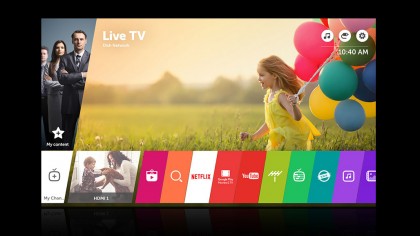
What surprised me most was the fairly easy to use universal search function that allows you to voice search the LG Content Store and pull up results from almost all the major providers. Use the built-in microphone on the remote to search for The Departed and it will pull up a page with links to Amazon Instant Video, Vudu and Google Play Movies & TV, and give a brief synopsis alongside the cast list.
Voice search, like the platform as a whole, isn't as intuitive or as robust as full-on video streaming boxes like the Roku 3, Roku 4, Chromecast or Amazon Fire TV, but what's there is basic enough for all but the most dedicated of cinephiles to get by.
TL;DR: Good Smart TV capabilities
HD/SDR Performance
By and large, performance across the board is excellent. Like a premium engine, though, the OLED E6 runs better with premium content. But it gets along well enough with standard fuel.
However, after watching a mix of shows from Netflix and playing a fair bit of Xbox One, I can report back that while flesh tones have a bit too much of a red hue for my taste, 90% of HD/SDR content looked good.
Color reproduction is overall excellent. The blacks are as deep and dark as you'd expect, and there's a decent amount of clarity when you have the right 1080p source feeding into it.
That said – and this might sound like heresy to OLED purists out there who believe that LG's panels are the best thing for cable since, well, ever – but the OLED E6 can't always turn a lemon into lemonade. What I mean here is that, if you take an older film – say Back to the Future II – and throw it on LG's $5,500 TV, you might not be all that impressed.

Some upscaled images on the OLED E6's massive 65-inch screen have that overblown look – like there's too much space to cover and not enough pixels to do it. This stretching can create a few jagged edges or, worse, a horrible blotch of colors on the screen.
It's a herculean task to ask a TV to perform well in every single aspect and you can only do so much with the content you're given, but I'd be wrong if I said that there's no room for improvement here.
TL;DR: All right HD/SDR performance
4K/HDR Performance
But while HD/SDR content wasn't everything I had hoped for, 4K/HDR content was everything I had ever dreamed it could be. The image quality can be broken down into a few parts: color, contrast, brightness and motion after you take upscaling out of the equation.
Starting with color, the OLED E6 nails it in every respect. It's a 10-bit panel on the inside and hits the Rec.2020 standard for color depth. All that means is that the colors can take on 1.07 billion hues and that, for the most, part are as accurate as possible to the source.
In terms of brightness, the LG OLED E6 has a minimum peak brightness of 540 nits and is capable of sinking all the way down to 0.0005 nits when the scene's right. Now, if you're concerned that 540 nits won't be enough, remember that OLED – like plasma before it – operates on a different scale. Just because it might not have the peak brightness of the LCD LED you've been eying, doesn't mean it won't be able to wow you when you've got a stark-white scene on the TV.
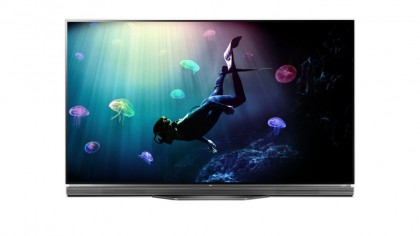
Contrast, OLED's specialty, is as good as it gets here. Watching Star Trek on 4K HDR Blu-ray I was often awestruck at how rich the CGI space looked and how omniscient the vastness of space appeared on the massive 65-inch screen. The TV fared well with non-Sci-Fi content as well (do yourself a favor and watch The Fundamentals of Caring when you get the chance), with forest scenes or cityscapes appropriately contrasted against one another.
All that said, the one setting I didn't quite like was LG's TruMotion, which often gave slower scenes a soap opera effect if left on. It's meant for fast-motion sequences – car chases, sports, fight scenes and the like – but it's enabled by default which means you'll need to turn it off periodically after it finds its way back on.
TL;DR: Amazing 4K/HDR performance
Sound
While most series come with lousy down-firing speakers, LG's OLED E6 sports a tremendously powerful and ultra-crisp soundbar right in the box. The soundbar is actually part of the stand and while it could be removed from the setup and swapped out for a Dolby Atmos 7.1.2 system, the 40-watt 2.2 speaker system is already pretty powerful on its own.
I could spend hours going on about the ample noise it generates (the speaker goes up to 100, and I had mine set at a room-filling 12), how you can custom-tune it to your living room via a the remote's built-in microphone or how it strikes the balance between mids, lows and highs, but I'd rather focus on its other neat feature: screen casting through a function called DIAL.
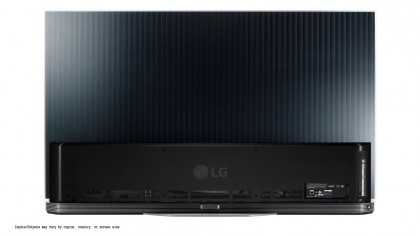
Similar to Google Cast, DIAL allows you to share your mobile device or laptop's screen directly to the biggest TV in your house with just a few clicks. There are other TVs with more integrated solutions out there – just look at Vizio's SmartCast series, for example – but if you're looking for crazy deep black levels and this kind of connectivity, LG's OLED is the only place to find it.
TL;DR: Amazing sound quality
Other panels to ponder…
On the subject of competitors, if you're looking for similar sets from Samsung and Sony, you should consider the Sony XBR-X930D, which comes in 55- and 65-inch variations, or the Samsung KS9500 with the company's proprietary SUHD tech inside it and comes in 55, 65 and 75-inch versions.
You'll save at least $3,000 by picking Sony over LG and around $2,000 by going for the Samsung. That said, expect to lose out on some of that jaw-dropping contrast that only OLED can provide and less screen uniformity when you switch to traditional LED backlights.
Verdict
The LG OLED65E6 is a premium 65-inch TV for a premium price. Like a top-tier engine, it works better when it's being fed high-quality fuel (read: 4K HDR content), but it can get by on standard if you can't find anything better.
Nice touches like the soundbar stand, built-in Google Cast capabilities and 3D add work in tandem with the OLED panel itself to deliver quality second-to-none, save for the company's own flagship Signature G6 OLED TV that comes in at a few thousand dollars more.
If you're looking for a killer 65-inch and have $5,500 on hand, there should be nothing stopping you from going all-in with OLED. That said, if you can live without the 4K capabilities, soundbar and some of those other add-on features, check out LG's 55EC9300 which is a premium 1080p panel with many of the same picture quality characteristics.
Nick Pino is Managing Editor, TV and AV for TechRadar's sister site, Tom's Guide. Previously, he was the Senior Editor of Home Entertainment at TechRadar, covering TVs, headphones, speakers, video games, VR and streaming devices. He's also written for GamesRadar+, Official Xbox Magazine, PC Gamer and other outlets over the last decade, and he has a degree in computer science he's not using if anyone wants it.
